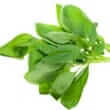Background
- The two primary types of basil are closely related: Ocimum basilicum (sweet basil), which is a staple of Italian and Asian cooking, and Ocimum sanctum (holy basil), which has a religious use or origin in different cultures. Both forms are native to India and Southeast Asia, although they are grown around the world.
- Holy basil has been used extensively for its medicinal values by a number of cultures. Chinese medicine uses holy basil for stomach spasms, kidney conditions, to promote blood circulation, and to treat snake and insect bites.
- In India, holy basil is known as tulsi, which translates as "incomparable one." The plant, which is considered sacred, is used extensively in religious ceremonies and is believed to protect any home where it is grown. According to Ayurvedic tradition, tulsi is one of the best herbs to prepare the heart and mind for spiritual practices, resolve colds and flu, treat various skin conditions, and reduce fever.
- Modern research on holy basil suggests that holy basil contains powerful antioxidants and it may be hepatoprotective (liver protecting). Also, preliminary clinical studies are investigating holy basil's effect on ulcers and blood sugar levels in type 2 diabetics. Holy basil has generally recognized as safe (GRAS) status in the United States.
References
Natural Standard developed the above evidence-based information based on a thorough systematic review of the available scientific articles. For comprehensive information about alternative and complementary therapies on the professional level, go to . Selected references are listed below.
- Agrawal P, Rai V, Singh RB. Randomized placebo-controlled, single blind trial of holy basil leaves in patients with noninsulin-dependent diabetes mellitus. Int J Clin Pharmacol.Ther. 1996;34(9):406-409.
View Abstract - Aqil F, Khan MS, Owais M, et al. Effect of certain bioactive plant extracts on clinical isolates of beta-lactamase producing methicillin resistant Staphylococcus aureus. J Basic Microbiol. 2005;45(2):106-114.
View Abstract - Goel RK, Sairam K, Dorababu M, et al. Effect of standardized extract of Ocimum sanctum Linn. on gastric mucosal offensive and defensive factors. Indian J Exp.Biol. 2005;43(8):715-721.
View Abstract - Grover JK, Vats V, Yadav SS. Pterocarpus marsupium extract (Vijayasar) prevented the alteration in metabolic patterns induced in the normal rat by feeding an adequate diet containing fructose as sole carbohydrate. Diabetes Obes.Metab 2005;7(4):414-420.
View Abstract - Joshi H, Parle M. Evaluation of nootropic potential of Ocimum sanctum Linn. in mice. Indian J Exp.Biol. 2006;44(2):133-136.
View Abstract - Mukherjee R, Dash PK, Ram GC. Immunotherapeutic potential of Ocimum sanctum (L) in bovine subclinical mastitis. Res Vet.Sci 2005;79(1):37-43.
View Abstract - Narendhirakannan RT, Subramanian S, Kandaswamy M. Mineral content of some medicinal plants used in the treatment of diabetes mellitus. Biol.Trace Elem.Res 2005;103(2):109-115.
View Abstract - Ravindran R, Rathinasamy SD, Samson J, et al. Noise-stress-induced brain neurotransmitter changes and the effect of Ocimum sanctum (Linn) treatment in albino rats. J Pharmacol.Sci 2005;98(4):354-360.
View Abstract - Samson J, Sheela Devi R, Ravindran R, et al. Biogenic amine changes in brain regions and attenuating action of Ocimum sanctumin noise exposure. Pharmacol.Biochem.Behav. 2006;83(1):67-75.
View Abstract - Sembulingam K, Sembulingam P, Namasivayam A. Effect of Ocimum sanctum Linn on the changes in central cholinergic system induced by acute noise stress. J Ethnopharmacol. 1-15-2005;96(3):477-482.
View Abstract - Shokeen P, Ray K, Bala M, et al. Preliminary studies on activity of Ocimum sanctum, Drynaria quercifolia, and Annona squamosa against Neisseria gonorrhoeae. Sex Transm.Dis. 2005;32(2):106-111.
View Abstract - Singh S, Malhotra M, Majumdar DK. Antibacterial activity of Ocimum sanctum L. fixed oil. Indian J Exp.Biol. 2005;43(9):835-837.
View Abstract - Subramanian M, Chintalwar GJ, Chattopadhyay S. Antioxidant and radioprotective properties of an Ocimum sanctum polysaccharide. Redox.Rep. 2005;10(5):257-264.
View Abstract - Udupa SL, Shetty S, Udupa AL, et al. Effect of Ocimum sanctum Linn. on normal and dexamethasone suppressed wound healing. Indian J Exp.Biol. 2006;44(1):49-54.
View Abstract







